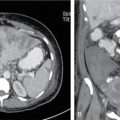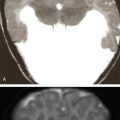3.28: Posterior skull base (CP angle lesions and seventh/eighth cranial nerves)
R.S. Aarathhi Dhevi Vikramavel, Subarekha TB, S. Rajakokila
Abbreviations
- AICA – Anterior inferior cerebellar artery
- CPA – Cerebellopontine angle
- ECA – External carotid artery
- ELST – Endolymphatic sac tumour
- EP – Ecchordosis physaliphora
- FD – Fibrous dysplasia
- GJP – Glomus jugulare paraganglioma
- IAC – Internal auditory canal
- ICA – Internal carotid artery
- LCH – Langerhans cell histiocytosis
- PICA – Posterior inferior cerebellar artery
- PSB – Posterior skull base
- vHL – von Hippel Lindau
Introduction
Relevant anatomy
Cerebellopontine angle – Internal auditory canal:
Boundaries – pons medially, posterior surface of the temporal bone laterally, cerebellum posteriorly, prepontine cistern anteriorly, tentorial leaf superiorly and IX- XI cranial nerves inferiorly.
(Please see Chapters 3.26 and 3.27 for further details and images)
Contents of the cerebellopontine angle cistern:
| Facial nerve |
| Vestibulocochlear nerve |
| AICA loop |
| Choroid plexus of 4th ventricle at the foramen of Luschka |
| Flocculus of cerebellum |
- 1. Facial nerve
- There are four components of nerve fibres within the facial nerve
- • General somatic efferent – motor supply to muscles of facial expression, stapedius, posterior belly of digastric and stylohyoid
- • Special visceral efferent – parasympathetic secretomotor supply to lacrimal gland, submandibular and sublingual salivary glands.
- • General somatic afferent – sensory input from the pinna and external auditory canal.
- • Special visceral afferent – taste sensation from the anterior two-thirds of the tongue, soft palate and floor of the mouth.
- • General somatic efferent – motor supply to muscles of facial expression, stapedius, posterior belly of digastric and stylohyoid
- Main motor nucleus of the facial nerve is located in the inferior pons at the level of the inferior cerebellar peduncle. The parasympathetic nuclei of the facial nerve – the superior salivatory and lacrimal nuclei are located just posterolateral to motor nucleus. The sensory nucleus is located just posterolateral to the parasympathetic nuclei.
- Motor root of the facial nerve curves posteriorly around the abducent nucleus and forms the facial colliculus at the floor of the fourth ventricle and leaves the brainstem at the pontomedullary junction.
- The sensory and parasympathetic efferent supply is via the nervus intermedius which leaves the brainstem between the motor root of facial nerve and vestibulocochlear nerve. It traverses along with the facial nerve in the cerebellopontine angle and internal auditory canal.
- The facial nerve is divided into intracranial, intratemporal and extracranial segments; the intracranial segment has intraaxial, cisternal and meatal segments. Of these the cisternal and meatal segments lie in the CPA -IAC region.
- Further details about facial nerve anatomy are discussed in the chapter on cranial nerves.
- There are four components of nerve fibres within the facial nerve
- 2. Vestibulocochlear nerve
- Cochlear nerve
- The spiral ganglia, which are bipolar – having two axonal projections from a nerve cell, are located in the cochlear modiolus. From the spiral ganglia, the peripherally projecting axons project on to the hair cells of organ of corti in the scala media of cochlea. The centrally projecting axons of the spiral ganglia coalesce to form the cochlear nerve and pass through anteroinferior part of the fundus of internal auditory canal.
- Superior vestibular nerve arises from the vestibule, passes through the superior part of macula cribrosa to enter the internal auditory canal.
- Inferior vestibular nerve – multiple branches pass through the inferior part of macula cribrosa and join to form the inferior vestibular nerve. Singular nerve from the ampulla of the posterior semicircular canal also passes through the macula cribrosa inferior and joins the inferior vestibular nerve.
- At the region of porus acousticus, the cochlear and vestibular nerves join together and form the vestibulocochlear nerve.
- Up to the level of the porus acousticus the VIII nerve is covered by Schwann cells. Just medial to the porus acousticus, it acquires the oligodendritic cover of central nervous system. [It has the longest oligodendritic cover among cranial nerves – ∼15 mm, from the porus acousticus to its root entry zone]. As a result most schwannomas originate lateral to the porus acousticus, that is, from the canalicular portion of the nerve.
- The vestibulocochlear nerve enters the brainstem at the level of the inferior cerebellar peduncle.
- Cochlear nerve
- 3. Loop of anterior inferior cerebellar artery in the IAC
- The AICA arises from the basilar artery in most cases. It traverses posteriorly abutting the anterior surface of the pons. In mid–course, it loops laterally to reach the porus acousticus. In 20% of individuals, it enters the IAC before turning back on itself to course along the anterior surface of cerebellum. It is divided into the pre-meatal, meatal and post-meatal segments accordingly. In the meatal segment, it gives off the internal auditory branch that supplies the cochlea. The territory supplied by AICA includes cochlea, flocculus and area of the brainstem containing the nuclei of VII and VIII nerves.
- 4. Choroid plexus of fourth ventricle at foramen of Luschka
- 5. Flocculus of cerebellum – may be associated closely with the VII and VIII nerves in the cerebellopontine angle cistern
Embryology
The internal auditory canal develops as an independent event from the development of external, middle and inner ear. So its presence or absence is not connected to the development of external, middle or inner ear.
The internal auditory canal develops as a result of migration of VII and VIII nerves through this region. So the fewer the number of nerves, smaller the canal. If it is very small and only one nerve is seen, in most cases it is the VII nerve.
Jugular fossa
It lies between the temporal and occipital bone. It is partly divided into two parts by the jugular spine
Erosion of the jugular spine is a sign of jugular fossa neoplasms.
Hypoglossal canal
It lies inferomedial to the jugular fossa and is within the condylar portion of the occipital bone. It transmits the cranial nerve XII and condylar vein.
On coronal CT, the jugular tubercle separating the hypoglossal canal and jugular fossa is visualized as an ‘eagle’s beak’. Lesions from the jugular fossa cause erosion of the outer superolateral surface of the jugular tubercle while lesions from the hypoglossal canal erode the inner inferomedial surface.
Foramen magnum
It is formed completely by the occipital bone, transmits the medulla oblongata, cranial nerve XI and the vertebral arteries.
Stylomastoid foramen
It is found between the mastoid process and styloid process of the temporal bone. It transmits the cranial nerve VII and directly extends to the parotid space.
Lesions of the posterior skull base
Approach
Pathological conditions of the posterior fossa can be divided based on their origin
Lesions common to anterior, middle and posterior skull base are covered comprehensively under anterior skull base – Chapter 3.26.
Lesions unique to posterior skull base
Cerebellopontine angle lesions
CPA schwannoma
Schwannoma is the commonest lesion of the cerebellopontine angle in an adult (60%–90%).The cranial nerve VIII is the commonest cranial nerve to be affected by schwannomas. As they arise most commonly from the vestibular division, they are called vestibular schwannomas. They usually present as unilateral sensorineural hearing loss. Other symptoms include tinnitus and giddiness. The age of presentation is usually 40–60 years.
Vestibular schwannomas often arise from the Schwann cells at the glial – Schwann cell junction near the porus acousticus.
The intracanalicular portion of the tumour is ovoid or cylindrical in shape. The extracanalicular portion is spherical or globose, forming an acute angle with the posterior surface of petrous temporal bone. The classic appearance is that of ‘ice cream cone’, where the intracanalicular portion forms the cone and extracanalicular cisternal portion forms the ice cream.
The tumour is classified based on the size of the extracanalicular portion. Small – if extracanalicular portion is <5 mm, medium – if it is 5 mm to 2 cm, large – if 2–4 cm and giant – if it is > 4 cm.
Calcification is uncommon. Micro/macro-haemorrhage is common in larger lesions. Intra-tumoral cystic change seen in about 15% tumours. Peritumoural arachnoid cysts or trapped CSF can be seen.
Imaging features.
On CT, the lesion is hyperdense with respect to CSF and shows enhancement on contrast. Bony changes – Widening of internal auditory canal (difference of >2 mm when compared to the contralateral side) and flaring/funnelling of the porus acousticus are best appreciated on CT. Larger lesions show mass effect over the brainstem and cerebellum.
MRI is the investigation of choice.
Heavily T2 weighted thin section volume sequences (CISS/SPACE, FIESTA, 3D DRIVE) are used as screening tools.
Almost all acoustic schwannomas can be picked up in thin section post contrast T1 weighted images in axial and coronal planes (Figs. 3.28.1–3.28.7). The report should include a mention about the following important pre-surgical and prognostic information
Stay updated, free articles. Join our Telegram channel

Full access? Get Clinical Tree








